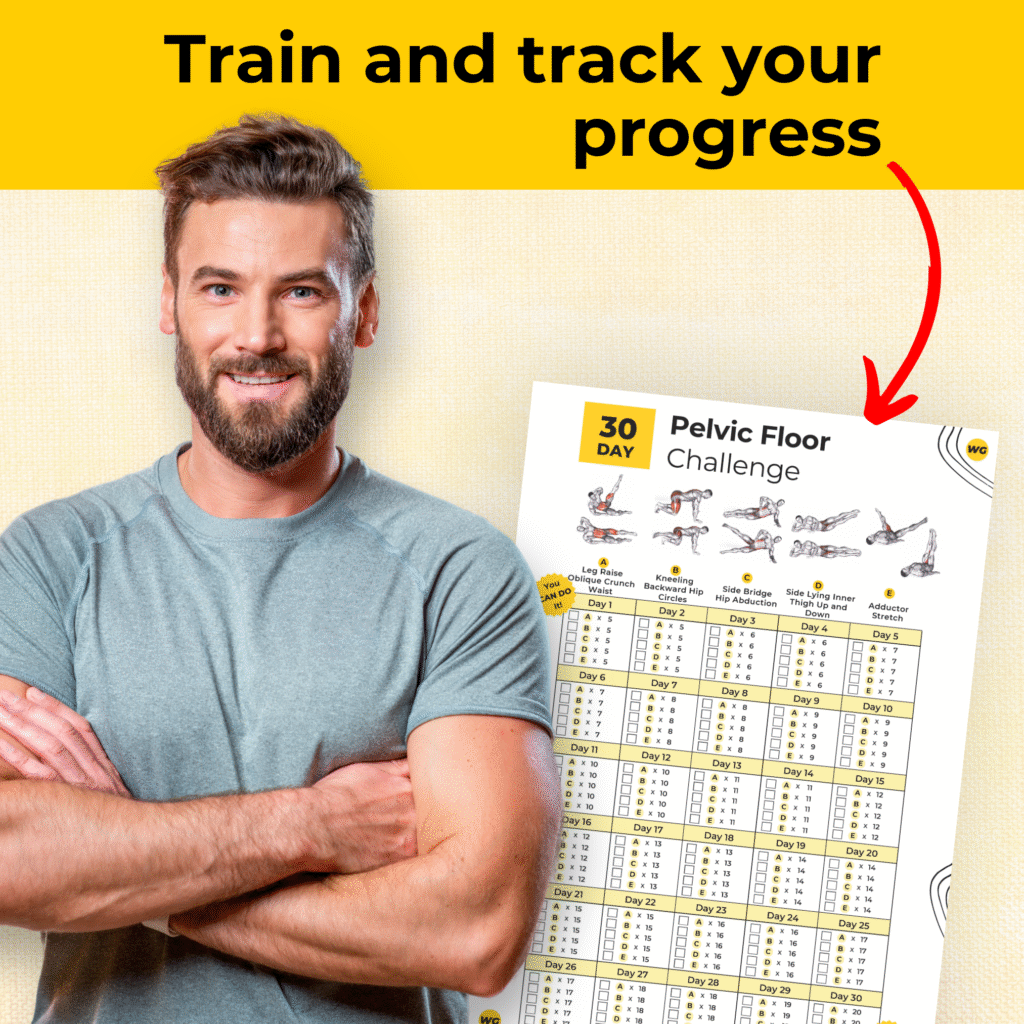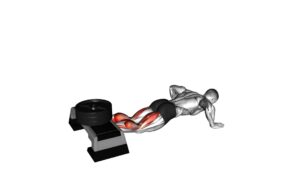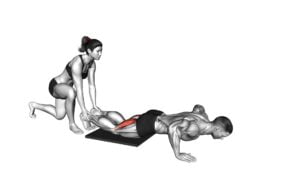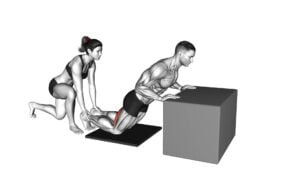Self Assisted Inverse Leg Curl (VERSION 3) – Video Exercise Guide & Tips
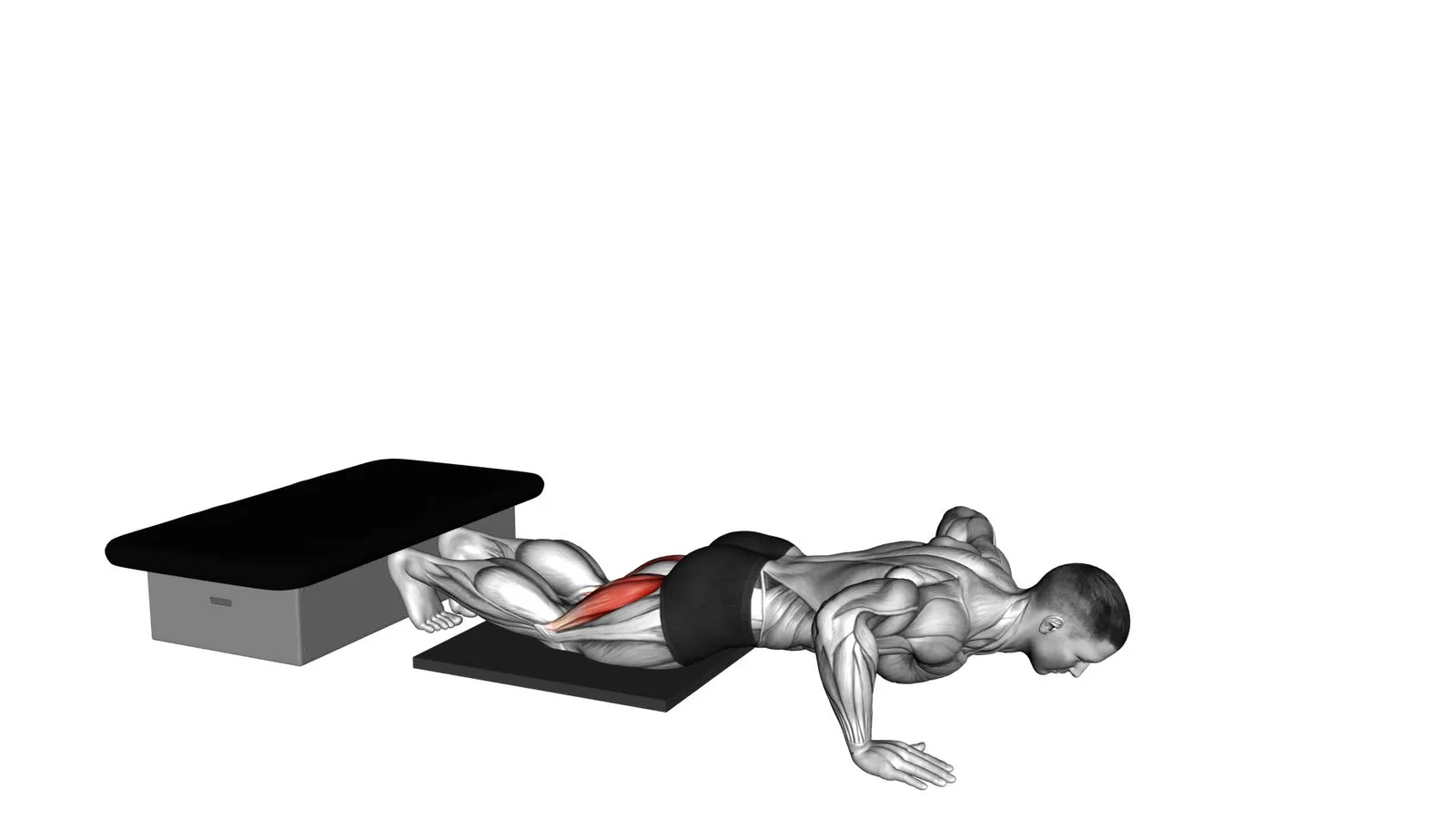
Are you looking for a challenging leg exercise that you can do on your own? Look no further than the self-assisted inverse leg curl!
Watch This Exercise Video
In this version 3 of the exercise, we'll guide you through the proper form and technique using a step-by-step video guide. Whether you're a beginner or an advanced user, we've got modifications for you.
Get ready to strengthen those legs and maximize your results with our helpful tips. Let's dive in!
Key Takeaways
- The self-assisted inverse leg curl targets the hamstrings and glutes for improved strength and stability.
- It increases hamstring flexibility, which helps with proper movement and injury prevention.
- The exercise provides lower back support, reducing strain during the movement.
- Proper form and technique, as well as core engagement, are important for maximizing results and avoiding common mistakes.
Proper Form and Technique
Use your own bodyweight to perform the Self Assisted Inverse Leg Curl with proper form and technique. This exercise is highly effective in targeting the hamstrings and glutes while also engaging the core muscles. To maximize results and avoid common mistakes, it's crucial to focus on the following key points.
Firstly, start by lying flat on your back with your arms extended by your sides. Bend your knees and place your feet flat on the ground, hip-width apart. Keep your toes pointed forward throughout the movement. This initial position ensures stability and proper alignment.
Next, engage your core and squeeze your glutes as you lift your hips off the ground. Simultaneously, extend your legs straight out in front of you, maintaining a slight bend in the knees. Your body should form a straight line from your shoulders to your feet. This is the starting position for the exercise.
As you begin the movement, slowly bend your knees and curl your legs towards your glutes. Focus on using your hamstrings to perform the curling motion. Keep your hips lifted and avoid any excessive swinging or jerking. Control the movement throughout to maintain tension in the targeted muscles.
To achieve optimal results, aim for a full range of motion by fully extending your legs and curling them as close to your glutes as possible. Remember to breathe steadily and avoid holding your breath.
Equipment Needed for the Exercise
To continue with the discussion on proper form and technique for the Self Assisted Inverse Leg Curl, let's now move on to the equipment needed for this exercise.
The Self Assisted Inverse Leg Curl is a bodyweight exercise that primarily targets the hamstrings. The only equipment you'll need for this exercise is a sturdy, stable surface to anchor your feet. A padded bench or step is ideal for this purpose. It should be positioned in such a way that when you lie down on your stomach, your feet can comfortably rest on top of it.
The beauty of the Self Assisted Inverse Leg Curl is that it requires minimal equipment, making it a convenient exercise that can be performed almost anywhere. The simplicity of the equipment needed also allows for various exercise variations. For instance, if you don't have access to a padded bench or step, you can use a stability ball or even a foam roller as an alternative. These variations can add an extra challenge to the exercise by increasing instability and engaging additional stabilizer muscles.
Now that you know the equipment needed for the Self Assisted Inverse Leg Curl, let's move on to the next section, which will provide you with a step-by-step video guide to help you perform this exercise correctly.
Step-By-Step Video Guide
Watch the video below to learn how to properly perform the Self Assisted Inverse Leg Curl. This step-by-step video guide will provide you with the necessary instructions to execute the exercise correctly.
To begin, lie flat on your back on a mat with your legs extended and your arms by your sides. Place a resistance band around your feet and hold the ends of the band in your hands. Bend your knees and bring them towards your chest while keeping your feet flexed. Slowly extend your legs back to the starting position, maintaining control throughout the movement.
It is crucial to avoid common mistakes when performing the Self Assisted Inverse Leg Curl. One common error is using momentum to swing the legs up, which reduces the effectiveness of the exercise. Instead, focus on using your core and leg muscles to control the movement. Additionally, ensure that your lower back remains flat against the mat throughout the exercise to prevent excessive strain.
Now that you have learned the proper technique for the Self Assisted Inverse Leg Curl, let's move on to modifications for beginners and advanced users.
Modifications for Beginners and Advanced Users
Now let's discuss the modifications that are available for both beginners and advanced users when performing the Self Assisted Inverse Leg Curl.
For beginners, there are options to make the exercise more accessible and manageable, allowing them to gradually build strength and improve technique.
Advanced users, on the other hand, can adapt the exercise to add challenge and intensity, pushing their limits and maximizing the benefits of the workout.
Whether you're just starting out or looking to take your leg curl to the next level, these modifications will help you tailor the exercise to your fitness level and goals.
Beginner Modification Options
Choose from various modification options to tailor the Self Assisted Inverse Leg Curl exercise to your fitness level, whether you're a beginner or an advanced user. Here are some beginner modifications and alternative exercises you can try:
- Use a resistance band: If you find it challenging to perform the exercise without assistance, you can loop a resistance band around a stable object and then around your ankles. This will provide some support and make the movement easier.
- Perform a seated leg curl: If you're unable to do the self-assisted version, you can opt for a seated leg curl machine at the gym. This machine allows you to target the same muscles without the need for bodyweight support.
Advanced User Adaptations
To challenge yourself further, consider incorporating additional resistance or increasing the range of motion in the Self Assisted Inverse Leg Curl exercise.
For advanced user modifications, you can use ankle weights or resistance bands to add resistance to the exercise. This will increase the intensity and target your muscles in a different way.
Another option is to increase the range of motion by extending your legs further out or bringing them closer to your body. This will engage different muscle fibers and provide a greater challenge.
Progressions and variations are key to advanced training techniques. By constantly challenging your body with new modifications, you can continue to improve strength and muscle development.
Remember to always maintain proper form and listen to your body to avoid injury.
Benefits of the Self Assisted Inverse Leg Curl
The Self Assisted Inverse Leg Curl offers several muscle activation benefits, including targeting the hamstrings and glutes. By engaging these muscle groups, you can improve strength and stability in the lower body.
Additionally, this exercise helps to increase hamstring flexibility, which is crucial for proper movement and preventing injuries.
Lastly, the self-assisted aspect of this exercise provides lower back support, reducing strain and allowing for a more controlled and effective workout.
Muscle Activation Benefits
You can experience numerous muscle activation benefits from performing the Self Assisted Inverse Leg Curl. This exercise targets the hamstrings, which are crucial for lower body strength and stability.
Here are the muscle activation benefits of the Self Assisted Inverse Leg Curl:
- Increased hamstrings activation: The Self Assisted Inverse Leg Curl specifically targets the hamstrings, activating and strengthening these muscles effectively.
- Improved muscle balance: By targeting the hamstrings, this exercise helps to balance the muscle strength between the front and back of your thighs, reducing the risk of muscle imbalances and potential injuries.
- Enhanced functional performance: Strong hamstrings are essential for activities like running, jumping, and squatting. Performing the Self Assisted Inverse Leg Curl can improve your overall athletic performance and functional abilities.
Increased Hamstring Flexibility
By performing the Self Assisted Inverse Leg Curl, you can increase your hamstring flexibility. This exercise specifically targets the hamstrings, which are the muscles located on the back of your thighs. The movement involved in the Self Assisted Inverse Leg Curl helps to stretch and strengthen these muscles, leading to improved flexibility.
Hamstring flexibility is important for various reasons, including injury prevention and enhanced athletic performance. Having flexible hamstrings can help prevent common injuries such as strains and tears, as they provide better support and stability to the knees and lower body. Additionally, increased hamstring flexibility allows for a greater range of motion during physical activities and exercises, leading to improved overall performance.
Now, let's move on to the next section, which discusses the importance of lower back support during the Self Assisted Inverse Leg Curl.
Lower Back Support
To maintain a stable and supported lower back during the Self Assisted Inverse Leg Curl, focus on engaging your core muscles. This is crucial for preventing lower back pain and reducing the risk of injury.
Here are some benefits of the Self Assisted Inverse Leg Curl in terms of lower back support:
- Improved spinal alignment: Engaging your core muscles helps maintain proper alignment of the spine, reducing stress on the lower back.
- Increased stability: By activating your core, you create a solid foundation for your lower back, enhancing stability during the exercise.
- Enhanced proprioception: Core engagement improves your body's awareness of its position and movements, allowing you to maintain control and prevent excessive strain on the lower back.
Tips for Maximizing Results and Avoiding Common Mistakes
Maximize your results and avoid common mistakes by maintaining proper form and utilizing the correct amount of resistance during the self-assisted inverse leg curl exercise. To maximize your results, focus on engaging your hamstrings throughout the movement. This will ensure that you're targeting the intended muscles and getting the most out of each repetition.
One common mistake to avoid is using too much momentum. It can be tempting to swing your legs up using your lower back or hips, but this takes the emphasis away from the hamstrings and reduces the effectiveness of the exercise. Instead, focus on using controlled movements and contracting your hamstrings to lift your legs.
Another mistake to avoid is using too much or too little resistance. Using too much resistance can lead to poor form and potential injury, while using too little resistance may not provide enough challenge to effectively stimulate muscle growth. Start with a moderate amount of resistance and adjust as needed to maintain proper form and feel a strong contraction in your hamstrings.
Lastly, make sure to maintain proper body alignment throughout the exercise. Keep your spine neutral and avoid rounding your back or arching excessively. This will help to prevent unnecessary strain on your lower back and ensure that the target muscles are being properly engaged.
Frequently Asked Questions
How Many Sets and Reps Should I Do for the Self-Assisted Inverse Leg Curl?
To determine the optimal progression for the self-assisted inverse leg curl, you need to consider the number of sets and reps.
It's important to start with a suitable level of difficulty and gradually increase as you get stronger. Begin with 2-3 sets of 8-12 reps and focus on maintaining proper form throughout each repetition.
If you find it too challenging, try modifying the exercise by using a lighter resistance band or reducing the range of motion.
Remember to listen to your body and adjust accordingly.
Can I Perform the Self-Assisted Inverse Leg Curl on a Regular Exercise Mat or Do I Need a Specific Type of Equipment?
You can perform the self-assisted inverse leg curl on a regular exercise mat or any suitable surface.
This exercise offers several benefits compared to traditional leg curl exercises, such as engaging the hamstrings and glutes more effectively.
It can be modified and varied to accommodate different fitness levels. Beginners can start with lighter resistance bands or decrease the range of motion, while advanced individuals can increase the resistance or perform single-leg variations.
Is It Normal to Feel Some Discomfort or Strain in the Hamstrings During the Exercise?
Feeling some discomfort or strain in your hamstrings during the exercise is normal. To prevent this, it's important to focus on maintaining proper form and technique. Make sure to engage your core and keep your back straight throughout the movement.
Avoid any jerking or swinging motions and control the movement with your hamstrings. If you experience excessive discomfort, try adjusting the resistance or range of motion. Remember to listen to your body and take breaks if needed.
What Muscles Are Primarily Targeted During the Self-Assisted Inverse Leg Curl?
The self-assisted inverse leg curl primarily targets the hamstring muscles. This exercise is highly beneficial for hamstring development as it helps to strengthen and tone these muscles.
By using your body weight as resistance, you can effectively work the hamstrings without the need for additional equipment.
For advanced athletes, variations and progressions of the self-assisted inverse leg curl can be incorporated to further challenge the muscles and enhance overall hamstring strength and stability.
Can the Self-Assisted Inverse Leg Curl Be Incorporated Into a Full Lower Body Workout Routine?
Incorporating the self-assisted inverse leg curl into your lower body workout routine can offer numerous benefits for overall leg strength. By targeting the muscles in your hamstrings and glutes, this exercise helps to build strength and stability in your lower body.
Additionally, the self-assisted version allows you to adjust the resistance to your individual fitness level, making it a suitable option for beginners or those recovering from an injury.
Including this exercise in your routine can help you achieve well-rounded lower body strength.
Conclusion
In conclusion, the self-assisted inverse leg curl is a highly effective exercise for targeting the hamstrings and glutes. By following the proper form and technique demonstrated in the step-by-step video guide, individuals can maximize their results and avoid common mistakes.
This exercise can be modified for both beginners and advanced users, making it suitable for individuals of all fitness levels. Incorporating the self-assisted inverse leg curl into your workout routine can lead to improved strength, muscle tone, and overall lower body stability.

Author
Years ago, the spark of my life’s passion ignited in my mind the moment I stepped into the local gym for the first time. The inaugural bead of perspiration, the initial endeavor, the very first surge of endorphins, and a sense of pride that washed over me post-workout marked the beginning of my deep-seated interest in strength sports, fitness, and sports nutrition. This very curiosity blossomed rapidly into a profound fascination, propelling me to earn a Master’s degree in Physical Education from the Academy of Physical Education in Krakow, followed by a Sports Manager diploma from the Jagiellonian University. My journey of growth led me to gain more specialized qualifications, such as being a certified personal trainer with a focus on sports dietetics, a lifeguard, and an instructor for wellness and corrective gymnastics. Theoretical knowledge paired seamlessly with practical experience, reinforcing my belief that the transformation of individuals under my guidance was also a reflection of my personal growth. This belief holds true even today. Each day, I strive to push the boundaries and explore new realms. These realms gently elevate me to greater heights. The unique combination of passion for my field and the continuous quest for growth fuels my drive to break new ground.




